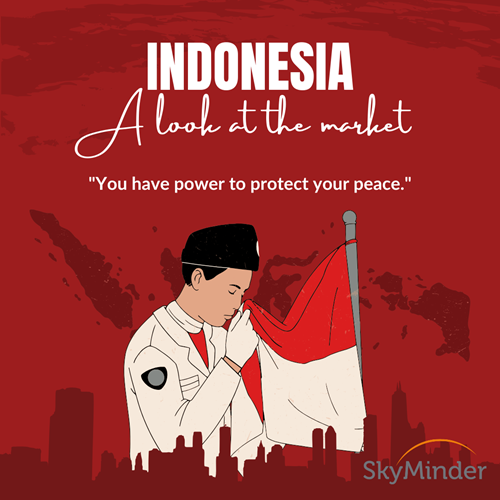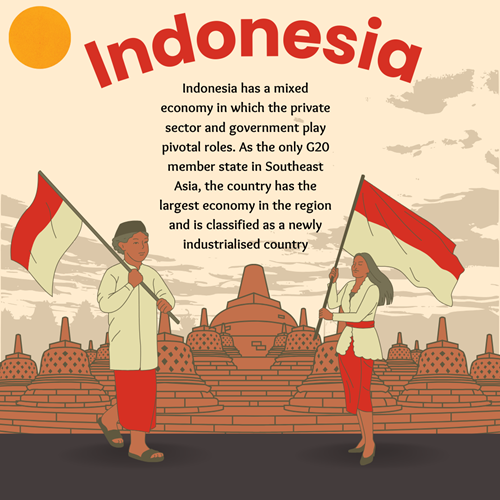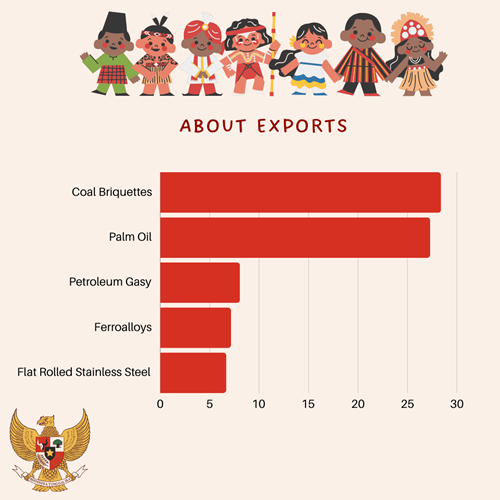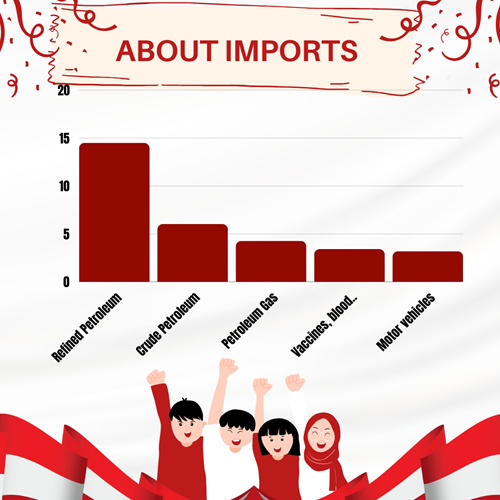Analysis and Studies - Country Analysis
Indonesia: a look at the market
March 1st 2024

Indonesia, officially the Republic of Indonesia, is a country in Southeast Asia and Oceania between the Indian and Pacific oceans. It is the world’s largest island country and the 14th largest century by area, with over 279 million people, It is also the world’s fourth most populous country.
Concerning economy, Indonesia has a mixed economy in which the private sector and government play pivotal roles. As the only G20 member state in Southeast Asia, the country has the largest economy in the region and is classified as a newly industrialised country. Moreover, It is the world’s 16th largest economy by nominal GDP in PPP is US$ 15,835, while nominal per capita GDP is US$5,108.
Indonesia has abundant natural resources. Its primary industries are fishing, petroleum, timber, paper products, cotton cloth, tourism, petroleum mining, natural gas, bauxite, coal and tin. Its main agricultural products are rice, coconuts, soybeans, bananas, coffee, tea, palm, rubber. These commodities make up a large portion of the country's exports, with palm oil and coal briquettes as the leading export commodities. In addition to refined and crude petroleum as the primary imports, telephones, vehicle parts and wheat cover the majority of additional imports. China, the United States, Japan, Singapore, India, Malaysia, South Korea and Thailand are Indonesia's principal export markets and import partners.
Tourism contributed around US$9.8 billion to GDP in 2020, and in the previous year, Indonesia received 15.4 million visitors. Overall, China, Singapore, Malaysia, Australia, and Japan are the top five sources of visitors to Indonesia. Since 2011, Wonderful Indonesia has been the country's international marketing campaign slogan to promote tourism.

Nature and culture are prime attractions of Indonesian tourism. The country has a well-preserved natural ecosystem with rainforests stretching over about 57% of Indonesia's land (225 million acres). Forests on Sumatra and Kalimantan are examples of popular destinations, such as the Orangutan wildlife reserve. Moreover, Indonesia has one of the world's longest coastlines, measuring 54,716 kilometres.
Overview
In 2021, Indonesia was the number 16 economy in the world in terms of GDP (current US$), the number 27 in total exports, the number 30 in total imports, the number 130 economy in terms of GDP per capita (current US$) and the number 61 most complex economy according to the Economic Complexity Index (ECI).
EXPORTS
The top exports of Indonesia are Coal Briquettes ($28.4B), Palm Oil ($27.3B), Petroleum Gas ($8.06B), Ferroalloys ($7.16B), and Large Flat-Rolled Stainless Steel ($6.68B), exporting mostly to China ($54.5B), United States ($26.2B), Japan ($18.6B), India ($14.5B), and Singapore ($13B).ù

In 2021, Indonesia was the world's biggest exporter of Palm Oil ($27.3B), Ferroalloys ($7.16B), Large Flat-Rolled Stainless Steel ($6.68B), Stearic Acid ($5.5B), and Lignite ($5.29B)
IMPORTS
The top imports of Indonesia are Refined Petroleum ($14.5B), Crude Petroleum ($6.03B), Petroleum Gas ($4.27B), Vaccines, blood, antisera, Petroletoxins and cultures ($3.42B), and Motor vehicles; parts and accessories (8701 to 8705) ($3.19B), importing mostly from China ($60.4B), Singapore ($18.4B), Japan ($13.2B), United States ($9.69B), and Malaysia ($9.55B).

In 2021, Indonesia was the world's biggest importer of Soybean Meal ($2.37B), Industrial Furnaces ($404M), Steam Boilers ($233M), Refractory Cements ($226M), and Artificial Filament Tow ($177M)
Fonti:
https://oec.world/en
https://data.worldbank.org/
https://www.trademap.org/
